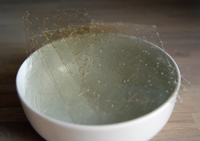
PVA-gelatin hydrogels formed using combined theta-gel and cryo-gel fabrication techniques.
Sign Up to like & getrecommendations! Published in 2019 at "Journal of the mechanical behavior of biomedical materials"
DOI: 10.1016/j.jmbbm.2019.01.002
Abstract: Poly(vinyl alcohol) (PVA) is a synthetic, biocompatible polymer that has been widely studied for use in bioengineered tissue scaffolds due to its relatively high strength, creep resistance, water retention, and porous structure. However, PVA hydrogels… read more here.
Keywords: cryo gel; gelatin hydrogels; pva; pva gelatin ... See more keywords

Hofmeister effect-assisted one step fabrication of fish gelatin hydrogels
Sign Up to like & getrecommendations! Published in 2020 at "Lwt - Food Science and Technology"
DOI: 10.1016/j.lwt.2019.108973
Abstract: Abstract Natural gelatin-based hydrogels are usually soft and fragile, and the preparation of hydrogels with elastic structures normally requires modification of gelatin chains or addition of chemical crosslinking agents. In this study, fish gelatin hydrogels… read more here.
Keywords: nh4 2so4; effect assisted; fish gelatin; hofmeister effect ... See more keywords

Preparation of a Strong Gelatin-Short Linear Glucan Nanocomposite Hydrogel by an in Situ Self-Assembly Process.
Sign Up to like & getrecommendations! Published in 2018 at "Journal of agricultural and food chemistry"
DOI: 10.1021/acs.jafc.7b04684
Abstract: Gelatin hydrogels exhibit excellent biocompatibility, nonimmunogenicity, and biodegradability, but they have limited applications in the food and medical industries because of their poor mechanical properties. Herein, we first developed an in situ self-assembly process for… read more here.
Keywords: self assembly; microscopy; situ self; assembly process ... See more keywords

Dynamic and Cell-Infiltratable Hydrogels as Injectable Carrier of Therapeutic Cells and Drugs for Treating Challenging Bone Defects
Sign Up to like & getrecommendations! Published in 2019 at "ACS Central Science"
DOI: 10.1021/acscentsci.8b00764
Abstract: Biopolymeric hydrogels have been widely used as carriers of therapeutic cells and drugs for biomedical applications. However, most conventional hydrogels cannot be injected after gelation and do not support the infiltration of cells because of… read more here.
Keywords: therapeutic cells; bone; gelatin hydrogels; cell infiltratable ... See more keywords

Energy release rate of gelatin hydrogels on glass surface in direct shear sliding experiments
Sign Up to like & getrecommendations! Published in 2018 at "Journal of Adhesion Science and Technology"
DOI: 10.1080/01694243.2018.1455796
Abstract: Abstract In this article, we determine experimentally the energy release rate (ERR) of gelatin hydrogels on a smooth glass surface in the direct shear mode using slide-hold-slide (SHS) experiments. The crack lengths and corresponding forces… read more here.
Keywords: glass surface; energy release; release rate; gelatin hydrogels ... See more keywords

Automated fabrication of photopatterned gelatin hydrogels for organ-on-chips applications.
Sign Up to like & getrecommendations! Published in 2018 at "Biofabrication"
DOI: 10.1088/1758-5090/aa96de
Abstract: Organ-on-chip platforms aim to improve preclinical models for organ-level responses to novel drug compounds. Heart-on-a-chip assays in particular require tissue engineering techniques that rely on labor-intensive photolithographic fabrication or resolution-limited 3D printing of micropatterned substrates,… read more here.
Keywords: organ chips; hydrogels organ; fabrication; heart chip ... See more keywords

Macromolecular interactions in alginate–gelatin hydrogels regulate the behavior of human fibroblasts
Sign Up to like & getrecommendations! Published in 2017 at "Journal of Bioactive and Compatible Polymers"
DOI: 10.1177/0883911516668667
Abstract: Due to the presence of tripeptide arginine–glycine–aspartic acid, gelatin is considered a very promising additive material to improve the cytocompatibility of alginate-based hydrogels. Two different strategies, physical blending and chemical crosslinking with gelatin, are used… read more here.
Keywords: alginate gelatin; macromolecular interactions; gelatin hydrogels; gelatin ... See more keywords

Modeling Patient-Specific Muscular Dystrophy Phenotypes and Therapeutic Responses in Reprogrammed Myotubes Engineered on Micromolded Gelatin Hydrogels
Sign Up to like & getrecommendations! Published in 2022 at "Frontiers in Cell and Developmental Biology"
DOI: 10.3389/fcell.2022.830415
Abstract: In vitro models of patient-derived muscle allow for more efficient development of genetic medicines for the muscular dystrophies, which often present mutation-specific pathologies. One popular strategy to generate patient-specific myotubes involves reprogramming dermal fibroblasts to… read more here.
Keywords: patient specific; gelatin hydrogels; muscle; muscular dystrophy ... See more keywords

A Simple Preparation Method of Gelatin Hydrogels Incorporating Cisplatin for Sustained Release
Sign Up to like & getrecommendations! Published in 2022 at "Pharmaceutics"
DOI: 10.3390/pharmaceutics14122601
Abstract: The objective of this study was to develop a new preparation method for cisplatin (CDDP)-incorporated gelatin hydrogels without using chemical crosslinking nor a vacuum heating instrument for dehydrothermal crosslinking. By simply mixing CDDP and gelatin,… read more here.
Keywords: gelatin hydrogels; cddp; ccgh; release ... See more keywords

Mechanically Reinforced Gelatin Hydrogels by Introducing Slidable Supramolecular Cross-Linkers
Sign Up to like & getrecommendations! Published in 2019 at "Polymers"
DOI: 10.3390/polym11111787
Abstract: Tough mechanical properties are generally required for tissue substitutes used in regeneration of damaged tissue, as these substitutes must be able to withstand the external physical force caused by stretching. Gelatin, a biopolymer derived from… read more here.
Keywords: cross linked; cross; gelatin hydrogels; mechanical properties ... See more keywords